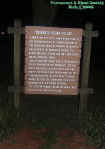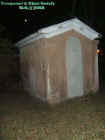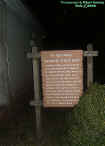|
|
||
|
Tolomato Cemetery perhaps might be the most well
known burial grounds in St. Augustine but not only that but it perhaps is
one of the oldest ones in the nation. Some call it the old Spanish burial
grounds as perhaps their are many unmarked graves that are said to exist
even beyond the cemeteries boundaries. The cemetery was started during the
British period as a burial place of Minorcans. Eventually it became a
Catholic Cemetery for various famous residents like Father Camps, Father
Verela, Bishop Jean Verot and General Jorge Biassou.
But what others often seem to forget is that despite it was started in 1737 before this it was the site of an Indian Village which thrived here. When the Spanish arrived here they made it a quest to convert the Indians to Christianity and Catholicism. The Tolomato Indian tribe learned to coexist with Cuban monks and missionaries. A church sat here where the cemetery is and burial grounds called Nuestra Senora de Guadalupe De Tolomato which was a mission. Eventually German Immigrants used the church here until the British came into power over the area. Many Christian Indians and Catholic Spanish were buried here. But the purpose of the cemetery was for the Minorcans who migrated to the area from New Smyrna due to Turnbull's failure to colonize the area they went to St. Augustine's. But the issue that was arising is where to bury the dead. Below is some information taken off the sign within the cemetery. During the First Spanish Period, prior to 1763, this site was occupied by the Christian Indian village of Tolomato, with its chapel and burying ground served by Franciscan missionaries. The village was abandoned when Great Britain acquired Florida. In 1777, Father Pedro Camps, pastor of the Minorcan colonists, who had come to St. Augustine after the failure of Andrew Turnbull’s settlement at New Smyrna, obtained permission from Governor Patrick Tonyn to establish this cemetery for his parishioners. Father Camps was buried here in 1790; ten years later his remains were re-interred in the "new church", the present Cathedral. The first bishop of St. Augustine, Augustin Verot (d. 1876), is buried in the mortuary chapel at the rear of the cemetery. The last burial took place in 1892. Later on the chapel was erected in the back of the cemetery down a narrow walking trail. It was built in 1853 to house the remains of Father Felix Varela. In 1911 his remains were relocated to Cuba. Also the chapel housed Pierre Agustin Verot's remains the first Bishop of St. Augustine's which were places there in 1876. Eventually they moved Father Varela to the center of the cemetery. Next to the cemetery Chief Tolomato was buried and the old drug store was moved on top of his grave hence the cemeteries name. Today the cemetery has suffered much vandalism and has been closed to the public with barbed wire and high fences. Many of the stones are cracked, broke in half, leaning, and some of the stones are one of a kind trust me when you see the photos taken here. I did something probably very few have done and that was go inside of Tolomato Cemetery by myself. I did not even bring a flashlight just wandered around as the moon slowly was creeping above the chapel. I found this to be quite a peaceful place however many others tell stories that are not so peaceful. There is a large older tree within the Cemetery where others have seen a child playing around it. Sometimes folks even seen the little boy sitting up in the tree just watching curiously. Then others have said to have seen a shadowy male figure which stands at the entrance to the chapel in back of the graveyard. Hell even a horror book was written about this place about an ancient dark god that was killing off the locals and the ghost of Chief Tolomato came back to stop it from the spirit world. So this is quite a place of great imagination and history. One of the most well known stories is about a wife who had perished of a illness I believe Yellow Fever. Friends carried her upright in a chair as her limp body just dangled lifeless. When they went to put her into the temple a thorn tree branch cut her open and she started to bleed. A friend seen her blink and after that she came to life living six more years where she died again. This time her husband had made sure that she would not be cut by the same tree which had revived her. © By Rick-AngelOfThyNight The saga of the Tolomato people, from Georgia to Florida to Cuba
|
||
|
|
|












